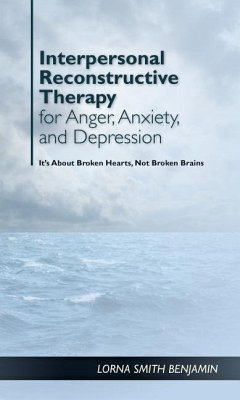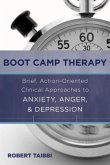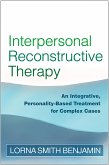Lorna Smith Benjamin
Interpersonal Reconstructive Therapy for Anger, Anxiety, and Depression: It's about Broken Hearts, Not Broken Brains
Lorna Smith Benjamin
Interpersonal Reconstructive Therapy for Anger, Anxiety, and Depression: It's about Broken Hearts, Not Broken Brains
- Gebundenes Buch
- Merkliste
- Auf die Merkliste
- Bewerten Bewerten
- Teilen
- Produkt teilen
- Produkterinnerung
- Produkterinnerung
This book shows clinicians and researchers how to use Interpersonal Reconstructive Therapy to change maladaptive patterns regarding safety and threat in treatment-resistant patients.
Andere Kunden interessierten sich auch für
![Chronic Depression: Interpersonal Sources, Therapeutic Solutions Chronic Depression: Interpersonal Sources, Therapeutic Solutions]() Jeremy W. PettitChronic Depression: Interpersonal Sources, Therapeutic Solutions24,99 €
Jeremy W. PettitChronic Depression: Interpersonal Sources, Therapeutic Solutions24,99 €![Boot Camp Therapy: Brief, Action-Oriented Clinical Approaches to Anxiety, Anger, & Depression Boot Camp Therapy: Brief, Action-Oriented Clinical Approaches to Anxiety, Anger, & Depression]() Robert TaibbiBoot Camp Therapy: Brief, Action-Oriented Clinical Approaches to Anxiety, Anger, & Depression28,99 €
Robert TaibbiBoot Camp Therapy: Brief, Action-Oriented Clinical Approaches to Anxiety, Anger, & Depression28,99 €![Interpersonal Reconstructive Therapy Interpersonal Reconstructive Therapy]() Lorna Smith BenjaminInterpersonal Reconstructive Therapy111,99 €
Lorna Smith BenjaminInterpersonal Reconstructive Therapy111,99 €![Treatment of Late-Life Depression, Anxiety, Trauma, and Substance Abuse Treatment of Late-Life Depression, Anxiety, Trauma, and Substance Abuse]() Treatment of Late-Life Depression, Anxiety, Trauma, and Substance Abuse76,99 €
Treatment of Late-Life Depression, Anxiety, Trauma, and Substance Abuse76,99 €![Anger, Aggression, and Interventions for Interpersonal Violence Anger, Aggression, and Interventions for Interpersonal Violence]() Anger, Aggression, and Interventions for Interpersonal Violence184,99 €
Anger, Aggression, and Interventions for Interpersonal Violence184,99 €![Secrets and Lies in Psychotherapy Secrets and Lies in Psychotherapy]() Barry A. FarberSecrets and Lies in Psychotherapy76,99 €
Barry A. FarberSecrets and Lies in Psychotherapy76,99 €![Metacognitive Interpersonal Therapy Metacognitive Interpersonal Therapy]() Giancarlo DimaggioMetacognitive Interpersonal Therapy189,99 €
Giancarlo DimaggioMetacognitive Interpersonal Therapy189,99 €-
-
-
This book shows clinicians and researchers how to use Interpersonal Reconstructive Therapy to change maladaptive patterns regarding safety and threat in treatment-resistant patients.
Hinweis: Dieser Artikel kann nur an eine deutsche Lieferadresse ausgeliefert werden.
Hinweis: Dieser Artikel kann nur an eine deutsche Lieferadresse ausgeliefert werden.
Produktdetails
- Produktdetails
- Verlag: American Psychological Association (APA)
- Seitenzahl: 316
- Erscheinungstermin: 8. Mai 2018
- Englisch
- Abmessung: 261mm x 181mm x 22mm
- Gewicht: 751g
- ISBN-13: 9781433828904
- ISBN-10: 1433828901
- Artikelnr.: 51260344
- Verlag: American Psychological Association (APA)
- Seitenzahl: 316
- Erscheinungstermin: 8. Mai 2018
- Englisch
- Abmessung: 261mm x 181mm x 22mm
- Gewicht: 751g
- ISBN-13: 9781433828904
- ISBN-10: 1433828901
- Artikelnr.: 51260344
Lorna Smith Benjamin, PhD, is a psychotherapist; creator of Structural Analysis of Social Behavior (SASB), a model for describing interactions with self and others; and creator of Interpersonal Reconstructive Therapy (IRT), which was developed for “treatment-resistant” psychiatric patients on the basis of what she learned after decades of using SASB in research and clinical practice. Dr. Benjamin got her undergraduate degree at Oberlin College and her graduate degree at the University of Wisconsin. During her graduate studies, she got firsthand experience with the continuity between infrahuman primates and humans as a graduate student of Harry Harlow in his laboratory at the University of Wisconsin. Her specializations there also included learning theory, neurophysiology, and mathematical psychology. That was followed in the department of psychiatry at the University of Wisconsin, Madison, by internship, more clinical training, and then academic appointments that progressed from research associate to full professor. A skiing addict, Dr. Benjamin moved to Utah in 1987, where she sponsored a dozen graduate students in the University of Utah department of psychology and concurrently held an appointment as adjunct professor in the department of psychiatry. Her assignment there was to consult for personality disordered cases at the University of Utah Neuropsychiatric Institute (UNI). Her psychopathology practicum at UNI eventually became the IRT clinic in 2002. Since then, she has collaborated extensively with Dr. Ken Critchfield, who joined Benjamin in the clinic first as a postdoctoral fellow, then as director of research, and later as director of the clinic until Benjamin retired in 2012. Critchfield moved to James Madison University, where, as associate professor, he continues to harvest information from the IRT database and teach clinical skills related to IRT. Benjamin resumed work at UNI on a part-time contract and presently is active offering consultations and in-house mini-workshops about psychothearpy, analyzing data, and writing. She also provides day-long or multiday workshops for professionals on IRT and SASB, usually emphasizing personality disorders
Preface
Chapter 1. Introduction and Overview
Part I. Foundational Concepts
Chapter 2. Natural Biology: Mechanisms of Psychopathology and Change
Chapter 3. Structural Analysis of Social Behavior: The Rosetta Stone for
Interpersonal Reconstructive Therapy Case Formulation and Treatment Models
Part II. The Case Formulation and Treatment Models
Chapter 4. The Interpersonal Reconstructive Therapy Case Formulation Model
Chapter 5. The Interpersonal Reconstructive Therapy Treatment Model
Chapter 6. Phases of the Action Stage of Change
Part III. Application of Interpersonal Reconstructive Therapyto Specific
Emotional Problems
Chapter 7. Anger
Chapter 8. Anxiety
Chapter 9. Depression
Part IV. Empirical Support
Chapter 10. Validity of the Interpersonal Reconstructive Therapy Models and
Effectiveness of Treatment
Glossary
References
Index
About the Author
Chapter 1. Introduction and Overview
Part I. Foundational Concepts
Chapter 2. Natural Biology: Mechanisms of Psychopathology and Change
Chapter 3. Structural Analysis of Social Behavior: The Rosetta Stone for
Interpersonal Reconstructive Therapy Case Formulation and Treatment Models
Part II. The Case Formulation and Treatment Models
Chapter 4. The Interpersonal Reconstructive Therapy Case Formulation Model
Chapter 5. The Interpersonal Reconstructive Therapy Treatment Model
Chapter 6. Phases of the Action Stage of Change
Part III. Application of Interpersonal Reconstructive Therapyto Specific
Emotional Problems
Chapter 7. Anger
Chapter 8. Anxiety
Chapter 9. Depression
Part IV. Empirical Support
Chapter 10. Validity of the Interpersonal Reconstructive Therapy Models and
Effectiveness of Treatment
Glossary
References
Index
About the Author
Preface
Chapter 1. Introduction and Overview
Part I. Foundational Concepts
Chapter 2. Natural Biology: Mechanisms of Psychopathology and Change
Chapter 3. Structural Analysis of Social Behavior: The Rosetta Stone for
Interpersonal Reconstructive Therapy Case Formulation and Treatment Models
Part II. The Case Formulation and Treatment Models
Chapter 4. The Interpersonal Reconstructive Therapy Case Formulation Model
Chapter 5. The Interpersonal Reconstructive Therapy Treatment Model
Chapter 6. Phases of the Action Stage of Change
Part III. Application of Interpersonal Reconstructive Therapyto Specific
Emotional Problems
Chapter 7. Anger
Chapter 8. Anxiety
Chapter 9. Depression
Part IV. Empirical Support
Chapter 10. Validity of the Interpersonal Reconstructive Therapy Models and
Effectiveness of Treatment
Glossary
References
Index
About the Author
Chapter 1. Introduction and Overview
Part I. Foundational Concepts
Chapter 2. Natural Biology: Mechanisms of Psychopathology and Change
Chapter 3. Structural Analysis of Social Behavior: The Rosetta Stone for
Interpersonal Reconstructive Therapy Case Formulation and Treatment Models
Part II. The Case Formulation and Treatment Models
Chapter 4. The Interpersonal Reconstructive Therapy Case Formulation Model
Chapter 5. The Interpersonal Reconstructive Therapy Treatment Model
Chapter 6. Phases of the Action Stage of Change
Part III. Application of Interpersonal Reconstructive Therapyto Specific
Emotional Problems
Chapter 7. Anger
Chapter 8. Anxiety
Chapter 9. Depression
Part IV. Empirical Support
Chapter 10. Validity of the Interpersonal Reconstructive Therapy Models and
Effectiveness of Treatment
Glossary
References
Index
About the Author







